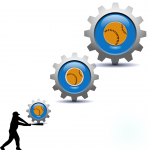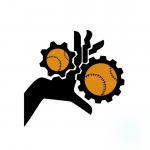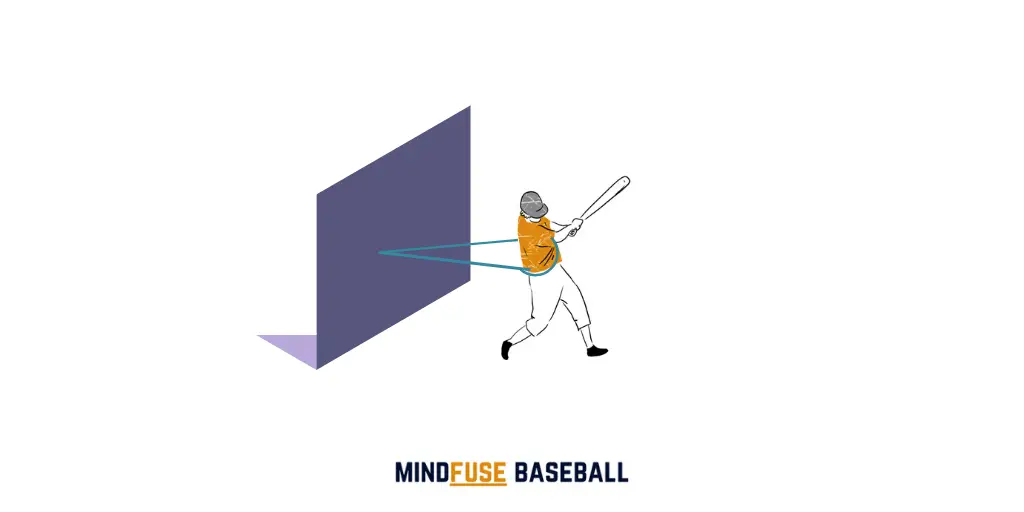Baseball Hitting Mechanics

5 Steps to Winning the Battle
Have you ever been left wondering how other batters manage to hit sweet line drives beyond the outfield with seemingly little effort?
The answer? Is proper hitting mechanics.
It’s true that as batters, we all want to achieve maximum velocity but this comes down to much more than just brute strength.
Your swing can be fast and look like it’s releasing a lot of energy but without proper mechanics and good technique, it’s worthless.
Hitting mechanics incorporate each physical part of the action involved in batting a ball from the moments before the ball is even pitched right up to the follow-through and it’s incredibly useful to understand them.
But, why?
There are two fundamental reasons behind understanding hitting mechanics:

Long-Term Development
Firstly, it drastically helps improve hitting because it allows baseball players to recognize individual mistakes that they’ve been making.
When you analyze your own mechanics, there might be a glaringly obvious mistake.
But, there can also be minuscule details that, when changed, will boost the distance of your hit.

Preventing Injuries
No matter where you are with your baseball development it’s important to do things the right way.
Poor mechanics can compound strain on your body and there’s a lot of potential to do long-term damage which needs to be avoided at all costs.
Good mechanics can offset the pressure you’re applying to your body.
So with that in mind, let’s break down the mechanics of hitting and see if there are some technical areas that you can change to improve your swing, add a few MPHs to your hit most but importantly, play for longer injury-free.
Finally, if you’re looking for high-quality, illustrated drills that’ll help you upgrade your batting average – check out our hitting drills guide
Step #1: Ready
Being prepared before hitting the ball is crucial to the timing and fluidity of the swing, both of which will affect the power output and velocity of the hit.
So, stepping up to the pate, hitters need to adopt a solid ready position, or what a lot of coaches refer to as a stance. The perfect stance is different for each individual. Some will have a much wider stance whereas others will want a shallower stance.
What’s important is that the hitter is comfortable, prepared and looking down the line. It’s also worth considering the following points when preparing to step up to the plate.
Grip
A correct grip on the bat handle is going to really help hitters achieve that whip in the swing and encourage better technique.
The best grip is when the hitter has their bottom hand facing upwards and their top hand facing down with no space between the hands.
The line of the gripping hands should be parallel to the toes.
If the grip isn’t stable the bat can slide or jerk on contact with the ball which will negatively impact the swing and it can be pretty uncomfortable on the wrists. Some batters also opt to wear a pair of batting gloves to protect their hands and absorb the pressure of the hit.
Bat Selection
This one often gets forgotten about but it’s really important.
If your bat is too heavy or too long for you it can negatively impact hitting mechanics.
A longer bat will provide more range but there will also be more load at the end making it more top-heavy.
So, don’t just pick up any old bat. Selecting the right bat for your training needs and playing needs is vitally important.
It’s always worth swinging a few bats at the tee to see what works for you.
Step #2: Load
This phase of hitting requires engaging the back foot to generate tension and power to be unleashed in the swing.
You’ll see various batters loading in different ways – some will really lift their front leg before the stride while others will make a much lighter lift of the front foot.
This is down to personal preference, but what’s important is the timing as you don’t want to load too early or too late as this can result in double-loading which we want to avoid at all costs as it kills the rhythm of the swing.
Step #3: Stride
From a loaded back leg, the hitter needs to move towards the ball to unleash that energy.
To do this, a stride is necessary.
Take the front foot forwards in the direction of the pitching mound before throwing the hands into the swing.
During the stride, the toes must remain lined up as they were in the ready position to maintain good rotation.
Avoid striding at an angle to keep the technique perfect every time.
Step #4: Swing
For a swing to be effective, hitters need to be balanced and in an active position.
To achieve this, avoid being static and tense in the ready position. Bend at the knees slightly, keep your hands moving about a little bit and stay on your toes.
All of these things will get your body in a rhythm and allow a more controlled swing.
Weight Distribution
When swinging at the ball, hitters need to distribute their weight from the loaded foot to the stride foot effectively.
To do this firmly plant the stride foot with the back knee dropping slightly.
This will increase the energy that your body is able to put into the swing.
Hip Rotation
An effective swing also requires optimum rotation.
Rotate too little and your swing won’t have the arc and range required to drive the ball whereas over-rotation can cause you to drag the ball sideways as well as causing hip, back and neck problems.
An effective swing keeps the barrel of the bat inside the boundary of the hitting zone for as long as possible.
Fire fast with your hands and follow through the whole arc of the rotation for a sweet hit.
Finish
An effective finish to the swing is crucial.
A badly executed finish can result in slicing the ball or dragging the swing out resulting in a pop-fly or a grounder to the infield.
Remember that the swing isn’t finished when contact is made with the ball.
Good hitting mechanics require bat extension after contact.
To do this, pivot the back foot allowing the hips to rotate further. This allows the bat to continue around the body and finish high.
The Fundamentals of Hitting a Baseball
Feet
For most hitters, the feet should be slightly wider than shoulder-width with the toes lined up and facing the pitching mound.
Some hitters will opt for a much wider stance but this is really down to what feels comfortable.
The important thing is a strong line. If your front foot is planted slightly in front of the back foot, this can be detrimental to the swing as it reduces the radius of hip rotation.
Hands
Position your hands above your toes at roughly the height of your chin.
This is the position from which you will swing at the ball.
Here’s a good way to help keep your hands in this position:
Visualize a vertical line rising from your toes.
This can act like a wall that you cannot put your hands behind.
Head
Throughout the whole swinging process…
Keep your eyes on the prize!
Avoid moving your head and lock your gaze on the ball.
If you take your eye off the ball, chance dictates that you’ll strike out.
Similarly, changing the position of your head mid-swing will throw your wing off balance.
How to Stop Lunging in Your Baseball Swing
Lunging at the ball can be really problematic for hitters because it removes all of the rhythm and fluidity of the swing.
Essentially, lunging means moving too early and forcing the stride which results in a much jerkier, rigid hit and overall bad mechanics.
So, what’s the best way to avoid it and remove lunging from your game?
It’s all about staying in control…
The best way to prevent lunging is to stay on your toes with an active posture. Bring your butt back slightly by hinging your hips and keep the body weight slightly over the back-side so that when the ball is pitched you’re prepared for the load.
Keeping this active posture and keeping your bodyweight back until the ball is pitched will allow you to stay in control.
Anticipate the pitch and ride your stride to keep the movement fluid.
How to Teach a Hitter (or Yourself) to Stay Back
It’s very common in younger players when they step up to the plate. Because they are so eager to unleash themselves on the ball, they fail to anticipate the pitch, striding too early and swinging wildly without any thought for mechanics.
For progressive training drills which help promote good mechanics, check out our drills page.
Band Assisted Hitting

Band Assisted Hitting is an especially great drill for younger players who find themselves lunging into their swing.
You’ll need to tie a resistance band around the waist of the player and attach that band to a fence or wall.
You can check out the details of this drill on the hitting drills guide here…
5 Tips How to Increase Your Bat Speed
Bat speed is one of the defining skills of some of the greatest baseball players in the world. A fast swing massively increases a player’s hit rate and it’s something that every player should consider improving.
Here’s a rundown of the key factors that will help you start the swing with more speed.
#1) Keep your hands level with your shoulders
- When you keep your hands level with your shoulders throughout a swing.
- You have greater control of the bat as your whole body is able to stay steady and exert more power.
- With your hands at this level, once the ball is pitched, you are able to take a faster swing.
When your hands are not at shoulder level, the bat feels much heavier, and therefore the swing becomes harder to make resulting in contact with the baseball coming too late.
#2) Stretch & Fire
As you fire at the ball, lead with your lower body and keep your upper body weight behind the swing.
- Your legs always begin the movement with the load and stride.
- Never begin swinging before initiating the stride.
- Doing this will make the timing of your swing completely off.
- This also make it difficult to generate speed.
One Handed Hit
- This is a superb drill to isolate your swing speed.
- First by kneeling down you’ll take the lower part of the body out of the equation.
- Now, it’s time to focus on a variety of one-handed hits using a stationary batting tee.
- Check out the video for full details.
#3) Pull Your Elbow Backwards
- As you begin the stride, move your elbow to load the swing and add more energy and speed.
- Imagine an archer pulling back the string of their bow…
- The further back they can pull, the more tension they can generate and the faster their arrow will travel.
- Moving your your elbow has a similar effect on the swing.
#4) Weight Shift
- The reason that hitters load their rear leg and move their elbow is to harness the energy that needs to be released.
- Some of the energy is released through the swing but to add even more power, it’s necessary to shift your body weight from the backside to the front foot and hands.
- The more momentum you can generate through weight transfer, the faster your swing will be.
#5) Tip Your Bat
- Giving your bat a slight tip in the path of the ball creates more swing momentum.
- This is because your barrel can move way faster once you’ve tipped your bat and especially with the energy you will put into the swing.
Hitting Mechanics FAQs
How Far Should a Batter’s Stride Be?
In all honesty, nobody can really say how long your stride should be when hitting a baseball.
Think about your favorite professional players – some will have a really big leg lift and a wide stride going into their swing while others swing with less exaggerated movements, but both types of stride are capable of producing incredible line drives.
The most important thing is staying in control.
If your stride isn’t in line then cracks start to form in the rest of your technique.
Generally speaking, a shorter stride can be more advantageous for your hit when it comes to staying in control, but it’s really about what feels good and comfortable.
Why Do I Keep Hitting Ground Balls?
If you’re consistently hitting grounders it could be for a number of reasons.
The most common cause is hitting over the ball in a downwards moment.
You should try and adjust your swing plane and if that doesn’t solve the problem, check the following:
- Timing: If you’re timing’s off you’re going to struggle to hit the sweet spot. Practice the swing off a tee applying all of the proper mechanics and tweak your swing accordingly. It might be worth recording yourself and doing a spot of video analysis to see if your timing is on point.
- Vision: We’ve said it before and we’ll say it again – Keep your eye on the ball through the whole swing to ensure you’re hit is on target.
- Balance: If you’re off balance during the swing you’ll struggle to hit properly.
- Over rotation: This is pretty much a product of bad timing and poor balance but can also occur if you’re hitting with the wrong size bat for you. Always make sure you’re using an appropriate bat.
Obviously, you want to hit the ball hard and therefore your wing needs to be fast.
However, if you’re swinging too fast without proper mechanics, chances are you’re going to throw your back out and injure yourself badly.
The most important thing is to keep everything fluid.
Perfect your technique at the tee at half speed and slowly increase the power until you’re comfortable.
As long as your technique is on point, the power will follow.
Baseball Hitting Equipment
Now you’ve read up on the mechanics of hitting, it’s time to get out there and apply it to your game.
Whether you’re training alone or with a coach or a pal, having the right equipment will allow you to get the most out of your practice.
Every hitter needs a good kit bag with a few tools to help advancement.
Here are our top pieces of hitting training equipment.
Baseball T-ball
While primarily for kids play, – it’s a phenomenal training aid for every level.
Hitting T-balls is a fantastic way to practice your form and perfect your technique.
Hitting Nets
Sick of chasing and collecting balls? We feel your pain.
A decent-sized hitting net is the best backstop out there and necessary aid for hitters.
You can choose from a variety of hitting nets to fit your backyard or find a collapsible, portable net if you’re looking to practice on the move.
Weighted Balls
For players looking to improve their finish and follow-through, we recommend investing in a set of weighted balls.
The added weight really encourages a full swing, proper rotation and good mechanics – not to mention the added power you’ll feel when it comes to hitting other types of baseballs such as a regulation baseball.